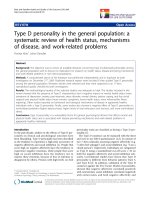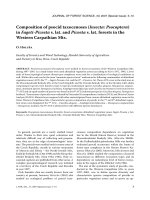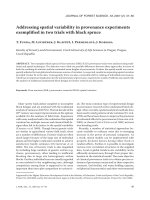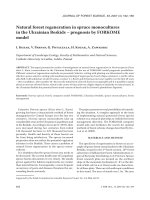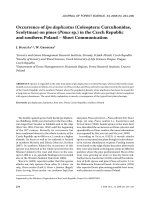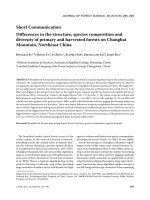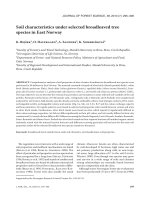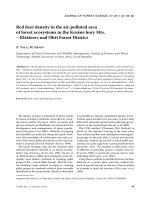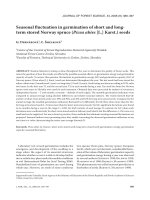Báo cáo lâm nghiệp: "Short Communication Differences in the structure, species composition and diversity of primary and harvested forests on Changbai Mountain, Northeast China" ppsx
Bạn đang xem bản rút gọn của tài liệu. Xem và tải ngay bản đầy đủ của tài liệu tại đây (332.22 KB, 10 trang )
J. FOR. SCI., 56, 2010 (6): 285–293 285
JOURNAL OF FOREST SCIENCE, 56, 2010 (6): 285–293
e broadleaf-conifer mixed forest occurs in the
cooler region of the eastern Eurasian continent,
extending across the coastal areas of eastern Rus-
sia, the Korean Peninsula, and the eastern portion
of northeastern China (N, I 1995).
Changbai Mountain, the core area of this vegetation
zone, is covered with a large area of broadleaved–Ko-
rean pine (Pinus koraiensis) mixed forest (S
et al. 2003). is is a typical vegetation type in the
eastern Eurasian Continent, and it has provided
large amounts of timber and is well-known for high
species richness and distinctive species composition
in temperate forests (Y, X 2003; S 2006).
Forest harvesting in Changbai Mountain region
began in the 1950s when state-owned forestry bu-
reaus were established. Prior to the 1980s, clearcut-
ting was the primary method for timber harvesting
in the region, since then selective logging methods
have been widely used. Due to nearly half a century
extensive harvesting in the region, large areas of pri-
mary forests have been degraded, timber resources
are declining and the age structure of the remaining
Supported by the National Natural Science Foundation of China, Projects No. 40873067 and 30800139 and 40601102, the
National Key Technologies R&D Program of China, Project No. 2006BAD03A09 and the National Forestry Public Welfare
Program of China No. 201104070.
Short Communication
Differences in the structure, species composition and
diversity of primary and harvested forests on Changbai
Mountain, Northeast China
DONGKAI SU
1, 2
, DAPAO YU
1
, LI ZHOU
1
, XIAOKUI XIE
1
, ZHENGGANG LIU
1
, LIMIN DAI
1
1
Chinese Academy of Sciences, Institute of Applied Ecology, Shenyang, China
2
Limited Liability Company, Jilin Forest Industry Group, Changchun, China
ABSTRACT: Broadleaved-Korean pine (Pinus koraiensis) mixed forest is a typical vegetation type in the eastern Eurasian
continent. We compared the structure, composition and diversity of a primary forest and a logged forest for effective
management and regeneration of a mixed forest ecosystem on Changbai Mountain, Northeast China. e logged for-
est was subjected to selective harvesting twenty years ago. e mean diameter and basal area for overall trees (≥ 2 cm
dbh) were higher in the primary forest than in the logged forest, whereas overall tree density was significantly lower
in the former (994 ± 34 treesha
–1
) than in the logged forest (1921 ± 79 treesha
–1
). e values of species richness and
both Simpson’s and Shannon’s diversity indices for seedlings (< 2 cm dbh, ≥ 50 cm tall), saplings (2−9.9 cm dbh) and
overall trees were greater in the primary forest. ese results indicate that the selective logging had a lasting impact on
the structural characteristics of the forest. ere were major differences in species composition between the two forest
sites, with the logged forest having more pioneer and mid-tolerant species than the primary forest. Diversity was more
extensive in the logged forest due to the invasion of pioneer species. Twenty years is clearly an insufficient time for the
logged forest to regain “primary” forest composition and structure. ese two characteristics of the primary forest may
serve as a reference for developing management plans for forest regeneration.
Keywords: broadleaved-Korean pine mixed forest; forest structure; species composition; species diversity
286 J. FOR. SCI., 56, 2010 (6): 285–293
forests has become unsuitable for sustainable for-
estry (S et al. 2001; Z, S 2002). In 1998,
the Chinese government established the Natural Fo-
rest Protection Program (NFPP), the major purposes
of which are to protect existing natural forests from
excessive logging and to restore degraded forests
(Z et al. 2000). While several studies on ve-
getation and flora have been conducted on Changbai
Mountain (e.g. L 1997; S et al. 2003; W et
al. 2004; L et al. 2005), there are few quantitative
studies on differences in the structure, composition
or diversity of primary and logged forests. e lack
of knowledge regarding these quantitative charac-
teristics of both primary and logged forests is one of
the major problems encountered in developing plans
for forest restoration.
A major objective of this study was to compare
the structure, composition and diversity of an un-
disturbed primary forest with those of an adjacent
forest that was subjected to selective logging twenty
years ago. e comparative nature of such informa-
tion is useful both for effective regeneration and
management of logged forests and the development
of ecosystem restoration projects. At the same time,
comparing primary and logged forest sites allows us
to examine how closely a logged forest may approach
the structure and composition of a primary forest
two decades after harvesting.
MATERIAL AND METHODS
e study was conducted on the northwest-facing
slope of Changbai Mountain in the northeastern
PR China (42°20'–42°40'N 127°29'–128°02'E, Fig. 1),
where the Lu Shuihe Forestry Bureau, a typical state-
owned forest enterprise, manages about 200,000 ha
of forests. e altitude of the study area ranges from
450 to 1,400 m a.s.l. e area has a temperate, con-
tinental climate, with long, cold winters and warm
summers. Mean annual precipitation is approxi-
mately 894 mm, most of which occurs from June to
September. Mean annual temperature is 2.9°C, with
a January mean of –16.3°C and a July mean of 19.2°C.
e soil is classified as dark brown forest soil. e
climax vegetation is the broadleaved-Korean pine
mixed forest. Major species include: Pinus koraien-
sis, Tilia mandshurica, Quercus mongolica, Fraxinus
mandshurica, Ulmus propinqua, and Acer mono.
e first study site was a primary forest with no
record of past logging (PF). e second study site
was an adjacent forest in which a timber harvest
was conducted in 1988 with a harvesting intensity
of 30% by volume (LF). In the summer of 2008, a
total of sixteen 40 × 40 m plots were established,
eight in each study site. Each plot was located at
least 100 m from the forest edge and separated by at
least 50 m from other plots. All plots were located
on gentle slopes (< 5°) at approximately 750 m of
elevation. Each plot was divided into four 20 × 20 m
subplots. In each subplot, all free-standing trees at
least 2 cm in diameter at breast height (dbh, 1.3 m
above the ground) were identified and measured.
Within each plot, two random 5 × 5 m quadrats
were used to record seedlings (< 2 cm dbh, ≥ 50 cm
tall). Tree data were divided into three size classes:
saplings (2−9.9 cm dbh), poles (10−29.9 cm dbh)
and large trees (≥ 30 cm dbh). Tree species were
further grouped according to their shade tolerance:
pioneer species, mid-tolerant species and shade
tolerant species.
Fig. 1. Location of the primary forest
(PF) and logged forest (LF) within
study area, located on the northwest-
facing slope of Changbai Mountain,
Northeastern China
Figure
Fig. 1. Location of the primary forest (PF) and logged forest (LF) within study area, located on the
northwest-facing slope of Changbai Mountain, Northeastern China
/)
3)
6WXG\DUHD
&KLQD
China
Study area
0 1 2
kilometers
0 5 10 15 20
kilometers
J. FOR. SCI., 56, 2010 (6): 285–293 287
Differences between the two forest sites with
respect to mean dbh, basal area, stem density and
three diversity indices (M 2004) – spe-
cies richness (S), Shannon’s diversity index (H’) and
Simpson’s diversity index (D) – were assessed using
t-tests. Species richness (S) was calculated as the
number of species recorded at the sampled area,
Shannon’s diversity index (H’) was calculated as
H' = –
∑
(p
i
log
2
p
i
)
and Simpson’s diversity index (D) was calculated as
D =
∑
p
i
2
where p
i
is the relative abundance of species i. As D
increases, diversity decreases and therefore Simpson’s
index is usually expressed as 1 – D or 1/D (O-
et al. 2004). In this study, the former expression
(i.e. 1 – D) was used. Normality and homogeneity of
variance were tested and data were log-transformed
if the homogeneity of variance was not met. ese
analyses were conducted using the software R
(R-Development Core Team 2004). Multi-response
permutation procedures (MRPP) within the PC-
ORD computer package (MC, M 2006)
were used to test for differences in species compo-
sition between the two forest sites. We conducted
MRPP analyses using the Sřrensen distance measure
(MC, G 2002).
RESULTS
Mean diameter, basal area and stand density dif-
fered significantly between the primary and logged
forest sites (Table 1). e mean diameter for overall
trees (≥ 2 cm dbh) was higher in PF (14.9 ± 0.3 cm)
than in LF (8.1 ± 0.2 cm) (t
14
= 18.24, P < 0.001),
although the mean diameters of saplings, poles
and large trees did not differ significantly between
the two forests (P > 0.05). e mean basal area for
overall trees was markedly lower in LF (27.08 ±
2.77 m
2
ha
–1
) than in PF (38.06 ± 1.79 m
2
ha
–1
)
(t
14
= 3.33, P < 0.01). Measures for the mean basal
area of saplings and large trees were also signifi-
cantly lower in LF than in PF (P < 0.01). Although
the mean basal area of poles was higher in PF (6.18 ±
0.42 m
2
ha
–1
) than in LF (5.12 ± 0.36 m
2
.
ha
–1
),
this difference was not significant (t
14
= 1.93, P =
0.074). Overall tree density was significantly greater
in LF (1,921 ± 79 treesha
-1
) than in PF (994 ±
Table 1. Structural characteristics (mean ± SE) of primary forest (PF) and logged forest (LF)
Parameter PF LF
Mean dbh (cm)
Saplings 4.9 ± 0.1 4.5 ± 0.3 t
14
= 1.22, P = 0.241
Poles 16.0 ± 0.3 15.5 ± 0.5 t
14
= 0.9, P = 0.383
Large trees 48.5 ± 0.9 47.1 ± 2.0 t
14
= 0.6, P = 0.559
Overall trees 14.9 ± 0.3 8.1 ± 0.2 t
14
= 18.24, P < 0.001
Basal area (m
2
ha
–1
)
Saplings 1.24 ± 0.09 2.95 ± 0.29 t
14
= −5.65, P < 0.001
Poles 6.18 ± 0.42 5.12 ± 0.36 t
14
= 1.93, P = 0.074
Large trees 30.64 ± 2.08 19.01 ± 3.26 t
14
= 3.01, P < 0.01
Overall trees 38.06 ± 1.79 27.08 ± 2.77 t
14
= 3.33, P < 0.01
Density (treesha
–1
)
Seedlings 6,350 ± 270 9,650 ± 196 t
30
= −9.58, P < 0.001
Saplings 559 ± 39 1,577 ± 85 t
14
= −10.85, P < 0.001
Poles 279 ± 24 246 ± 18 t
14
= 1.08, P = 0.301
Large trees 156 ± 6 98 ± 13 t
14
= 3.96, P < 0.01
Overall trees 994 ± 34 1,921 ± 79 t
14
= −10.76, P < 0.001
Seedlings: < 2 cm dbh, ≥ 50 cm tall; saplings: 2–9.9 cm dbh; poles: 10–29.9 cm dbh; large trees: ≥ 30 cm dbh;
overall trees: ≥ 2 cm dbh
288 J. FOR. SCI., 56, 2010 (6): 285–293
Family Species
Shade
tolerant
a
Seedlings Saplings Poles Large trees Overall trees
PF LF PF LF PF LF PF LF PF LF
Aceraceae Acer mandshuricum ST 150 0 15 0 27 0 2 0 44 0
Aceraceae Acer ginnala ST 0 0 2 0 0 0 0 0 2 0
Aceraceae Acer ukurunduense ST 2,150 1,450 31 49 2 1 0 0 33 50
Aceraceae Acer pseudo-sieboldianum ST 900 0 142 102 84 48 2 0 228 150
Aceraceae Acer triflorum ST 0 0 1 2 1 3 0 0 2 5
Aceraceae Acer tegmentosum ST 250 350 90 178 16 2 0 0 106 180
Aceraceae Acer mono ST 2,250 700 89 123 52 31 5 9 146 163
Aceraceae Acer tschonoskii ST 0 0 0 130 0 1 0 2 0 133
Betulaceae Betula platyphylla Pioneer 0 0 8 52 15 25 0 0 23 77
Betulaceae Betula costata MD 0 0 4 88 2 2 2 0 8 90
Betulaceae Carpinus cordata MD 0 0 66 0 1 0 0 0 67 0
Fagaceae Quercus mongolica Pioneer 0 0 2 20 2 3 13 8 17 31
Juglandaceae Juglans mandshurica MD 0 300 0 22 0 7 0 2 0 31
Leguminosae Maackia amurensis MD 50 1,200 3 9 3 5 0 0 6 14
Oleaceae Syringa amurensis MD 100 1,450 50 111 3 5 0 0 53 116
Oleaceae Fraxinus mandshurica ST 0 750 5 2 2 1 16 5 23 8
Pinaceae Pinus koraiensis ST 0 1,400 2 32 34 10 75 38 111 80
Pinaceae Abies nephrolepis ST 0 400 2 7 0 9 2 7 4 23
Pinaceae Picea jezoensis ST 0 0 0 0 0 1 0 0 0 1
Rhamnaceae Rhamnus davurica ST 0 0 0 2 0 0 0 0 0 2
Rosaceae Prunus padus ST 0 0 2 13 2 0 0 0 4 13
Rosaceae Malus baccata ST 0 0 5 19 1 2 0 0 6 21
Rosaceae Sorbus alnifolia ST 0 0 5 2 0 1 0 1 5 4
Rutaceae Phellodendron amurense MD 0 450 2 127 2 2 0 2 4 131
Table 2. Tree density (treesha
–1
) by size classes for all species in primary forest (PF) and in logged forest (LF)
J. FOR. SCI., 56, 2010 (6): 285–293 289
34 treesha
–1
) (t
14
= −10.76, P < 0.001). Seedlings
and saplings were significantly more abundant in
LF than in PF (P < 0.001), whereas large trees were
more abundant in PF (156 ± 6 treesha
–1
) than in LF
(98 ± 13 treesha
–1
) (t
14
= 3.96, P < 0.01). Although
pole density in PF (279 ± 24 treesha
–1
) exceeded
that in LF (246 ± 18 treesha
–1
), this difference was
not significant (t
14
= 1.075, P = 0.301).
A total of 28 tree species belonging to 20 genera
and 13 families were recorded on the two forest
sites (Table 2). In PF, 24 tree species were found,
representing 17 genera and 11 families; in LF,
25 species from 19 genera and 13 families were
identified. Of the overall number of tree species,
21 were present on both the primary and logged
forest sites: 6 species of seedlings, 19 species of
saplings, 15 species of poles and 9 species of large
trees (Table 2). With respect to tree density, for
saplings, poles and overall trees, the numbers per
hectare of pioneer species (such as S. matsudana,
P. davidiana and B. platyphylla) and mid-toler-
ant species (such as P. amurense and U. japonica)
were generally much higher in LF than in PF. In
contrast, the numbers per hectare of shade toler-
ant species (such as P. koraiensis and T. amurensis)
were higher for poles and larger trees in PF than
in LF (Table 2).
For all trees in PF, the top seven species ranked
in terms of basal area were P. koraiensis, T. amu-
rensis, F. mandshurica, Q. mongolica, A. pseudo-
sieboldianum, A. mono and U. japonica. These
seven species accounted for around 91% of the
total basal area in PF, whereas these same species
accounted for about 74% of total basal area in LF
(Table 3). It is noteworthy that the pioneer spe-
cies S. matsudana and P. davidiana were among
the top seven species ranked by the basal area
in LF but not in PF. Multi-response permutation
procedures (MRPP) demonstrated that there
were significant differences in species composi-
tion for seedlings (A = 0.418, P < 0.001), saplings
(A = 0.409, P < 0.001), poles (A = 0.165,
P < 0.001),
large trees (A = 0.142, P = P < 0.01) and overall
trees (A = 0.349,
P < 0.001) between the primary
and logged forest sites.
The values of species richness (S), Simpson’s
diversity index (D) and Shannon’s diversity index
(H’) all differed significantly between the primary
and logged forest (Table 4). e values of the three
indices for seedlings, saplings and overall trees
(≥ 2 cm dbh) were greater in LF than in PF (P < 0.05),
whereas there were no significant differences among
the three indices for poles and large trees between
the two forests (P > 0.05).
Family Species
Shade
tolerant
a
Seedlings Saplings Poles Large trees Overall trees
PF LF PF LF PF LF PF LF PF LF
Salicaceae Salix matsudana Pioneer 0 0 0 213 0 44 1 2 1 259
Salicaceae Populus davidiana Pioneer 0 0 0 98 1 20 1 5 2 123
Tiliaceae Tilia amurensis ST 0 950 20 116 22 10 32 13 74 139
Ulmaceae Ulmus japonica MD 500 250 13 60 7 13 5 4 25 77
Total 6,350 9,650 559 1,577 279 246 156 98 994 1,921
a
Pioneer – pioneer species; MD – mid-tolerant species; ST – shade tolerant species
Seedlings: < 2 cm dbh, ≥ 50 cm tall; saplings: 2–9.9 cm dbh; poles: 10–29.9 cm dbh; large trees: ≥ 30 cm dbh; overall trees: ≥ 2 cm dbh
Table 2. to be continued
290 J. FOR. SCI., 56, 2010 (6): 285–293
DISCUSSION AND CONCLUSION
Although the logged forest may outwardly resemble
the primary forest in some features like canopy height
and closed canopy stories, there are clearly important
structural differences between the two. For the logged
forest, the values of both stem density and basal area
of large trees were significantly lower than those for
the primary forest, while the numbers of seedlings
and saplings were significantly higher (Table 1). is
suggests that the selective harvest did have a lasting
impact on structural characteristics of the forest two
decades after harvesting. By initially decreasing over-
storey density and basal area, canopy openings created
by logging triggered a rapid increase in recruitment
into the seedling and sapling layers. e fact that the
density of seedlings and saplings of the logged forest
increased, confirmed that tree regeneration after selec-
tive logging was significantly stimulated. ese results
agree with those of many previous studies (e.g. L et
al. 1998; G, D2008).
Shifts in species composition may be related to
logging intensity (B, M 2001;
Z et al. 2006). For instance, N et al.
(2005) reported that restoring the species composi-
tion of clear-cut forests to that of primary forests
in central Japan was difficult; while other studies
have described anywhere from a limited response
to rapid recovery of species composition in a range
of forest types following various cutting methods
and intensities (e.g. S, M 2002;
K et al. 2006). In our study, the primary forest
was dominated by seven tree species (P. koraien-
sis, T. amurensis, F. mandshurica, Q. mongolica,
A. pseudo-sieboldianum, A. mono and U. japonica),
which accounted for 63% of all trees and 91% of the
total basal area (Tables 2 and 3). ese percentages
reflect the typical composition of the climax stage
of a broadleaved-Korean pine mixed forest (Z
et al. 2007). However, these seven tree species ac-
counted for only 34% of all trees and 74% of the total
basal area in the logged forest (Tables 2 and 3). ese
Table 3. Tree species accounting for 90% of the total basal area in primary forest (PF) and in logged forest (LF), trees
≥ 2 cm dbh
Site Tree species Family
Basal area
(m
2
ha
–1
) (%)
PF
Pinus koraiensis Pinaceae 15.26 40.11
Tilia amurensis Tiliaceae 6.62 17.40
Fraxinus mandshurica Oleaceae 4.49 11.80
Quercus mongolica Fagaceae 3.21 8.44
Acer pseudo-sieboldianum Aceraceae 2.02 5.31
Acer mono Aceraceae 1.90 4.99
Ulmus japonica Ulmaceae 1.18 3.10
17 other species 3.39 8.85
LF
Pinus koraiensis Pinaceae 9.31 34.38
Tilia amurensis Tiliaceae 3.38 12.48
Quercus mongolica Fagaceae 2.10 7.75
Acer mono Aceraceae 1.98 7.31
Salix matsudana Salicaceae 1.36 5.01
Populus davidiana Salicaceae 1.31 4.84
Abies nephrolepis Pinaceae 1.17 4.32
Ulmus japonica Ulmaceae 1.12 4.14
Acer pseudo-sieboldianum Aceraceae 1.04 3.84
Fraxinus mandshurica Oleaceae 1.00 3.69
Betula platyphylla Betulaceae 0.66 2.44
14 other species 2.65 9.80
J. FOR. SCI., 56, 2010 (6): 285–293 291
results indicate that the selective logging altered
the species composition by decreasing the number
of larger trees, leading to a significant increase in
stem density and basal area of pioneer species (e.g.
S. matsudana and P. davidiana) and mid-tolerant
species (such as P. amurense) (Table 2). As a result,
shade tolerant species would not become dominant
in the forest. e results of the multi-response per-
mutation procedures (MRPP) further confirmed the
dissimilarity of species composition in the primary
and logged forests.
Many studies have found that species diversity
increases after logging and that this change results
primarily from the invasion of pioneer species
(H, S 1995; C et al. 1998). Some
studies have reported an increase in diversity as a
short-term response of the system to logging (e.g.
P et al. 2000), while other studies have sug-
gested that logging either has a low effect on species
diversity (e.g. V, E-B 2003) or
actually leads to a decrease in diversity (e.g. O
et al. 2003). On an overall basis, changes in species
diversity vary considerably for different original
habitat types (N et al. 1999) and disturbance
regimes (E, S 1994). In our study, the
values of species richness, Simpson’s diversity index
(S) and Shannon’s diversity index (H’) for seedlings,
saplings and overall trees were greater in the logged
forest than in the primary forest, but the values of
the three indices for poles and large trees did not
demonstrate any significant differences between the
two forests (Table 4), indicating that the impacts of
selective logging on species diversity differed for
different diameter classes; selective logging contrib-
uted to increased species diversity for seedling and
sapling layers. is echoed the findings of H
and S (1995) and C et al. (1998).
In conclusion, although the logged forest may
share some superficial features with the primary
forest, the former still possesses only about 70% of
the basal area of the primary forest two decades after
harvesting. ere are still major differences in spe-
cies composition between the primary and logged
forest, with the latter having more pioneer species
and mid-tolerant species than the primary forest.
ere are also differences in species diversity, with
Table 4. Species diversity indices (mean ± SE) in primary forest (PF) and in logged forest (LF)
Parameter PF LF
Species richness (S)
Seedlings 4 ± 1 8 ± 1 t
30
= −5.4, P < 0.001
Saplings 11 ± 1 17 ± 1 t
14
= −5.68, P < 0.001
Poles 9 ± 1 11 ± 1 t
14
= −1.67, P = 0.118
Large trees 7 ± 1 6 ± 1 t
14
= 1.23, P = 0.239
Overall trees 15 ± 1 18 ± 1 t
14
= −3.96, P < 0.01
Shannon (H’)
Seedlings 1.78 ± 0.17 2.61 ± 0.16 t
30
= −3.51, P < 0.01
Saplings 2.71 ± 0.07 3.29 ± 0.13 t
14
= −3.85, P < 0.01
Poles 2.60 ± 0.07 2.78 ± 0.12 t
14
= −1.11, P = 0.286
Large trees 2.04 ± 0.10 2.20 ± 0.14 t
14
= −0.99, P = 0.34
Overall trees 3.18 ± 0.07 3.46 ± 0.11 t
14
= −2.19, P < 0.05
Simpson (D)
Seedlings 0.66 ± 0.02 0.79 ± 0.02 t
30
= −4.16, P < 0.001
Saplings 0.80 ± 0.01 0.86 ± 0.02 t
14
= −2.81, P < 0.05
Poles 0.78 ± 0.02 0.79 ± 0.03 t
14
= −0.26, P = 0.801
Large trees 0.67 ± 0.03 0.74 ± 0.03 t
14
= −1.77, P = 0.099
Overall trees 0.86 ± 0.01 0.89 ± 0.01 t
14
= −2.4, P < 0.05
Seedlings: < 2 cm dbh, ≥ 50 cm tall; saplings: 2–9.9 cm dbh; poles: 10–29.9 cm dbh; large trees: ≥ 30 cm dbh; overall trees:
≥2 cm dbh
292 J. FOR. SCI., 56, 2010 (6): 285–293
the logged forest displaying greater diversity than
the primary forest due to the invasion of pioneer
species. Twenty years is clearly an insufficient time
for the logged forest to return to the structure of the
‘primary’ forest. e present logging cycle needs to
be reconsidered from the perspective of both sus-
taining timber yields and ecologically sustainable
forest management; in the process the structure
and composition of the primary forest may be used
as a reference for developing management plans for
forest regeneration.
Acknowledgements
We would like to thank the Lu Shuihe Forestry Bu-
reau for providing assistance in field data collection.
We would also like to thank Dr. B J. L at
University of Missouri for editing assistance.
R e f e rence s
B J., M P. (2001): e impact of logging in-
tensity on field-layer vegetation in Swedish boreal forests.
Forest Ecology and Management, 154: 105–115.
C C.H., P D.R., L M. (1998): Tree spe-
cies diversity in commercially logged Bornean rainforest.
Science, 281: 1366–1368.
E K.J., S W.T. (1994): Changes in tree species
diversity after successive clearcuts in the Southern Ap-
palachians. Vegetatio, 115: 11–18.
G H., D L.M. (2008): Structural and compositional
responses to timber harvesting for an old-growth forest
on Changbai Mountain, China – Short Communication.
Journal of forest science, 54: 281–286.
H C.B., S T.A. (1995): Plant species diversity
in natural and managed forests of the Pacific Northwest.
Ecological Applications, 5: 913–934.
K C.C., P B.J., S T.F. (2006): Ground-layer
plant community responses to even-age and uneven-age
silvicultural treatments in Wisconsin northern hardwood
forests. Forest Ecology and Management, 230: 162–170.
L Q.J. (1997): Structure and dynamics of the subalpine
coniferous forest on Changbai Mountain, China. Plant
Ecology, 132: 97–105.
L Q.J., D L.M., CH H. (1998): Changes of com-
munity characteristics of a broad-leaved conifer mixed
forest after selection cutting. Journal of Forest Research,
9: 152–159.
L Q.J., L X.R., M Z.Q., T N. (2005): Monitoring
forest dynamics using satellite imagery–a case study in the
natural reserve of Changbai Mountain in China. Forest
Ecology and Management, 210: 25–37.
MC B., G J.B. (2002): Analysis of ecological commu-
nities. MjM Software Design, Gleneden Beach, Oregon.
MC B., M M.J. (2006): PC-ORD Multivariate
Analysis of Ecological Data, Version 5. MjM Software De-
sign, Gleneden Beach, Oregon.
N T., K T., N T. (2005): Effects of
different forest management systems on plant species diver-
sity in a Fagus crenata forested landscape of central Japan.
Canadian Journal of Forest research, 35: 2832–2840.
N T., I S. (1995): Composition, dynamics
and disturbance regime of temperate deciduous forests in
Monsoon Asia. Vegetatio, 121: 23–30.
O T., S M., A N., Q E.S., H
N.A., M N. (2003): Effect of selective logging on
canopy and stand structure and tree species composition in
a lowland dipterocarp forest in peninsular Malaysia. Forest
Ecology and Management, 175: 297–320.
O M., D I., A I., G C., A-
I. (2004): Vegetation diversity and vertical structure
as indicators of forest disturbance. Forest Ecology and
Management, 195: 341–354.
P D.A., B M.L., W S.D., G A.K. (2000):
Plant diversity and tree responses following contrasting
disturbances in boreal forest. Forest Ecology and Manage-
ment, 127: 191–203.
R Development Core Team (2004): R: A Language and Envi-
ronment for Statistical
Computing. R Foundation for Statistical Computing, Vienna,
Austria.
S R.M., M D.J. (2002): Understory spe-
cies patterns and diversity in old-growth and managed
northern hardwood forests. Ecological Applications, 12:
1329–1343.
S G.F., Y X.D., B H. (2003): Sensitivities of
species compositions of the mixed forest in eastern Eurasian
continent to climate change. Global and Planetary Change,
37: 307–313.
S G., Z P., B G., Z G., W Z. (2001):
Ecological classification system for China’s natural forests:
protection and management. Acta Ecologia Sinica, 21:
1564–1568. (In Chinese)
S R. (2006): A threatened nature reserve breaks down
Asian borders. Science, 313: 1379–1380.
V R., V E-B C. (2003): Effects of selective
logging on tree diversity, composition and plant functional
type patterns in a Bornean rain forest. Journal of Vegetation
Science, 14: 99–110.
W X. P., Z B., Z S.Q., P S.L., F J.Y. (2004):
Comparison of community structure and species diversity
of mixed forests of deciduous broad-leaved tree and Korean
pine in Northeast China. Biodiversity Science, 12: 174–181.
(In Chinese)
Y X., X M. (2003): Biodiversity conservation in Changbai
Mountain Biosphere Reserve, northeastern China: status,
problem, and strategy. Biodiversity and Conservation, 12:
883–903.
J. FOR. SCI., 56, 2010 (6): 285–293 293
Z E.K., K J.M., J R., P J., G J.
(2006): Responses of ground flora to a gradient of harvest
intensity in the Missouri Ozarks. Forest Ecology and Man-
agement, 222: 326–334.
Z J., H Z.Q., S B., Y J., L B.H., Y X.L. (2007):
Spatial distribution patterns and associations of Pinus ko-
raiensis and Tilia amurensis in broad-leaved Korean pine
mixed forest in Changbai Mountain. Chinese Journal of
Applied Ecology, 18: 1681–1687. (In Chinese)
Corresponding author:
Dr. L D, Chinese Academy of Sciences, Institute of Applied Ecology, 72 Wenhua Road, 110016 Shenyang,
P.R. China
tel./fax:+ 862 483 970 328, e-mail:
Z P.C., S G.F., Z G., L M D.C., P
G.R. D J.B. L Q.L. (2000): China’s Forest Policy for
the 21
st
Century. Science, 288: 2135–2136.
Z G., S G. (2002): Logging restrictions in China: A
turning point for forest sustainability. Journal of Forestry,
4: 34–37.
Received for publication August 9, 2009
Accepted after corrections November 5, 2009
INSTITUTE OF AGRICULTURAL ECONOMICS AND INFORMATION
Mánesova 75, 120 56 Prague 2, Czech Republic
Tel.: + 420 222 000 111, Fax: + 420 227 010 116, E-mail:
Account No. 86335-011/0100 KB
IBAN – CZ2201000000000086335011; SWIFT address – KOMBCZPPXXX
In this institute scientific journals dealing with the problems of agriculture and related
sciences are published on behalf of the Czech Academy of Agricultural Sciences. e
periodicals are published in English.
Number Yearly subscription
Journal of issues per year in USD
Plant, Soil and Environment 12 540
Czech Journal of Animal Science 12 660
Agricultural Economics (Zemědělská ekonomika) 12 540
Journal of Forest Science 12 480
Veterinární medicína (Veterinary Medicine – Czech) 12 720
Czech Journal of Food Sciences 6 420
Plant Protection Science 4 140
Czech Journal of Genetics and Plant Breeding 4 160
Horticultural Science 4 160
Research in Agricultural Engineering 4 140
Soil and Water Research 4 140
Subscription to these journals be sent to the above-mentioned address.
